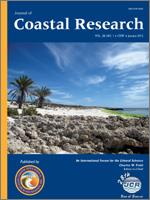LEAL, R.N.; BASSI, D.; POSENATO, R., and AMADO-FILHO, G.M., 2012. Tomographic analysis for bioerosion signatures in shallow-water rhodoliths from the Abrolhos Bank, Brazil.
Bioerosion at all scales is now recognized as playing a major role in facies interpretation. Macroscopic and microscopic borings can provide an indication of water depth, if they can be attributed to the action of specific borers. Tomographic analysis is a new method for assessing bioerosion, for identifying boring taxa, as well as for calculating the volume and porosity in present-day rhodoliths. The tomographic system provides also a quantification of the calcium carbonate produced by bioerosion. Recent rhodoliths collected at 20-m water depth on the Abrolhos Bank, Brazil, have been multiscann analyzed. The study shows that rhodoliths from this site are characterized by a highly diversified assemblage of boring bivalves and sponges associated producing the ichnogenera Gastrochaenolites and Entobia. The fauna from this boring assemblage can remove up to 10% of the rhodolith volume. The method can be expected to yield similar results as applied to both modern and fossil rhodoliths from other localities and time frames.





